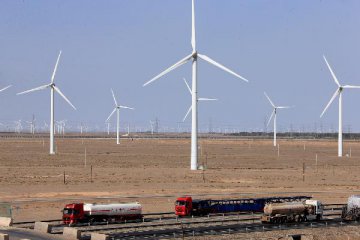
China's solar PV industry that has been long dependent on subsidies is expected to go through a key period for transformation and upgrades in 2016-2020. With the country's specified energy transformation policy as well as the industry's recovering performance, China's solar PV industry is transforming towards intelligent manufacturing for stronger competitive advantages, experts say. China will push forward energy reform, speed up energy technology innovation to construct clean, low-carbon, safe and high-efficient modern energy system, according to the Communist Party of China (CPC) Central Committee's "Proposal on Formulating the Thirteenth Five-Year Plan (2016-2020) on National Economic and Social Development" unveiled on November 3.
The proposal has set the tone for PV industry development during the 2016-2020 period, which means that PV industry is likely to make big breakthrough in areas such as product technology content and equipment intelligence, according to industry observers. -- China PV industry to further scale up in 2016-2020 China will speed up the development of wind power, solar power, biomass energy, hydropower, geothermal energy and develop nuclear energy safely and efficiently, said the proposal.
This is in line with the country's initiative of raising non-fossil energy ratio in the energy consumption structure for greener development, analysts say. Statistics released by the Ministry of Industry and Information Technology (MIIT) showed that China's solar PV installed capacity reached 35.78GW by the end of this June, exceeding the target set for 2011-2015 period six months ahead. Such speedy development made the target 100GW set for solar PV capacity by year of 2020 in the country's plan for combating climate change in 2014-2020 relatively conservative and it is widely anticipated that such development target would be raised.
China's PV power capacity will hit 150 GW by 2020, said Dong Xiufen, director of the new energy office with the National Energy Administration (NEA) earlier at an industry conference, noting that the country will continue expanding PV power generation in the next five years. However, experts point out that power utilization and efficiency should be attached more attention to during the 2016-2020 period under the background of speedy development. Renewable energy utilization is one of the key tasks under the undergoing power reform, they say, noting that the optimization of subsidies, intensifying competition, lowering cost, integration of the industry as well as the energy transformation could be ways for tackling renewable energy utilization bottlenecks.
-- Transform towards more intelligent development
The Fifth Plenary Session of the 18th CPC Central Committee has set the country's path towards innovative development, coordinative development, green development, open development and sharing development in the next five years' period, which are all closely linked with new energy industry, according to Zhu Ming, deputy director of the NEA's new and renewable energy department, noting that domestic PV industry should improve competitiveness, achieve price advantages to change previous reliance on subsidies.
The core of the new energy industry is cost reduction through technology progress and innovation, said Gao Jifan, head of China Photovoltaic Industry Association and CEO with Trina Solar. Energy reform covers the use of renewable energy as well as the smart utilization of energy, Gao said. To achieve on-grid parity for renewable energy by technological upgrades and cost reduction is the key factor for advancing energy reform, according to industry insiders.
The National Development and Reform Commission (NDRC), China's top economic planner, is currently soliciting opinions on reducing benchmark on-grid price of wind power and PV power generated electricity among local governments and power companies. The on-grid prices would be cut gradually along with industry scale expansion, the NDRC said. In the notice of adjusting on-gird wind power and PV power price for opinions, the NDRC said that the benchmark price of PV power in the first grade resource area would to be reduced 5.6 percent to 0.85 yuan/Kwh in 2016, and that in the second grade resource area reduced 3 percent to 0.92 yuan/Kwh.
The benchmark sale price will be reduced 0.03 yuan/Kwh each year from 2017 to 2020. The benchmark sale price of wind power in the first grade resource area will be cut 22.4 percent to 0.38 yuan/Kwh in 2020, and that in 4th grade resourcearea will be cut 14.8 percent to 0.52 yuan/Kwh. The cut of on-grid price would also force enterprises to reduce cost by innovation and upgrades, experts say. In fact, many domestic PV companies have already been working on transforming from manufacturing towards intelligent production.
This has led to differential performances among manufacturers, that leading companies operating at full capacity while second-tier and third-tier companies having fewer orders. Companies that lagging behind in terms of innovation would be phased out, industry insiders say. Trina Solar's mono-crystalline silicon experimental conversion rate has reached 24.4 percent and the company now only needs 12,000 personnel for the output of 6GW modules instead of 15,000 personnel for 1.6GW four years ago thanks to intelligent interconnections of equipments and facilities, according to a source with Trina Solar.
JinkoSolar's multi-crystalline 6-inch panel's efficiency has reached as high as 20.5 percent and that of mono-crystalline P-type 6-inch panel has reached 21.5 percent, said Qian Jing, vice president with JinkoSolar, noting that the company has now achieved automation of the production line. In the downstream sector, power stations are also moving towards intelligent management. Trina Solar, for example, has previously announced that it would bring in Envision's Apollo PV cloud-based platform to realize PV power station assert management based on big data. Solar PV industry is expected to achieve big breakthrough in areas such as product technology content and equipment intelligence, which would help push forward larger scale utilization of solar PV power, experts say.
Focus on 13th Five-Year Plan > Development Policy






















Latest comments